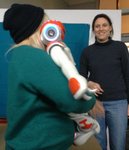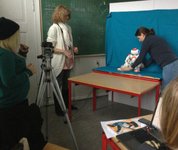Our research questions are:
What do the schools expect robots to contribute with in teaching?
How are the robots used in class and with which intentions?
Is there a dichotomy between what the schools imagine robots can do and their actual materiality and function in practice?
Unacknowledged effect
An unacknowedged effect of wanting to use robots as a teaching tool is an increase in the students' competitive mentality: the teaching tends to be less structured but more competitive, depending on the shape of and type of agenda behind the robot.
Contrast in expectation and performance
Robots are being purchased as innovative and progressive, and they are often considered more autonomous than is the case. Consequently, teachers spend much more time than expected implementing robots into their teaching. In other words, we see a gap between what is expected of the robots as innovative and their practical use/actual use.
Although our research is not longitudinal, the project tries to uncover shifts in perceptions and practices with robots in the past, present and future perspective. That is, we explore how the interrelation between materiality and the notion of the robot is constantly evolving and changing.
Empirical data and methodology
8 research assistants and 2 senior researchers have conducted field observations and collected empirical data at 9 schools, 1 robot competition sites and 3 robot development sites. We have conducted participant observations and interviewed more than 30 people including both managers, teachers and students.
All researchers have written field note reports from their observations sites. Moreover, we have gained insight into children's imagination of robots and robot functions through drawings. In all, RIF has collected more than 100 different drawings.
A full report on RIF findings will be published September 2016![]()


Senior researchers:
Cathrine Hasse
Gertrud Lynge
Research assistants:
Mathias Breum
Emilie Brinks
Anna Luna Carlsen
Stine Harrekilde
Mia Mathiasen
Luna Lund Mathisen
Nanna Møllnitz
Kira Pumali
Signe Rieland
Allan Sayedmirza